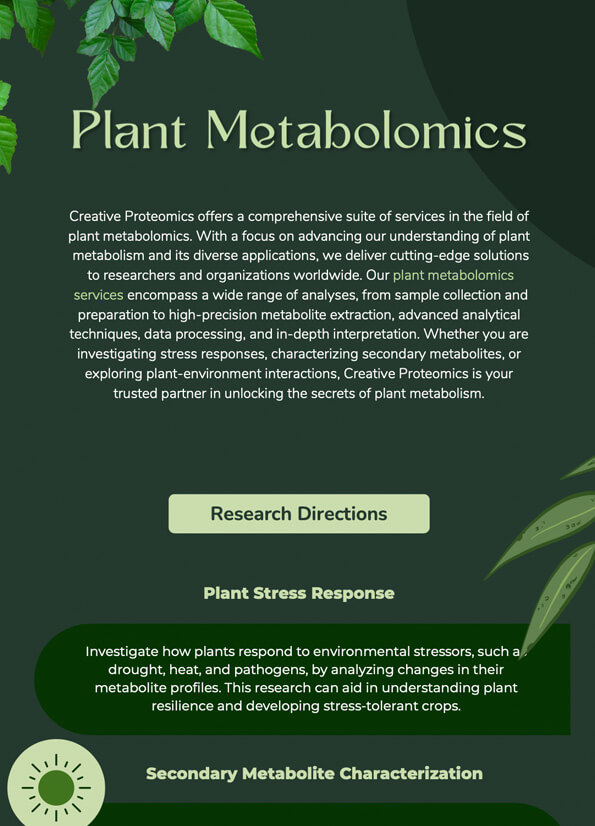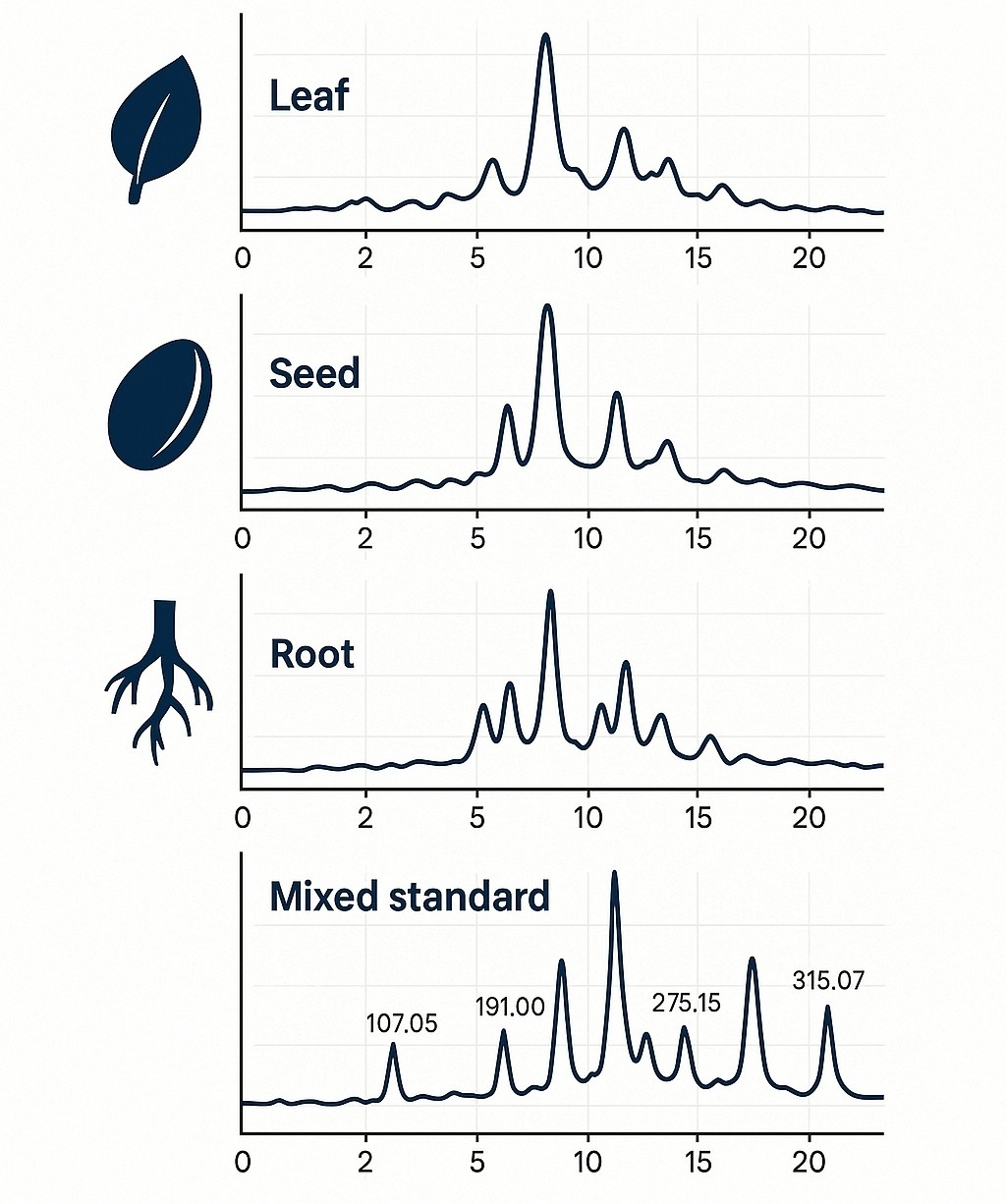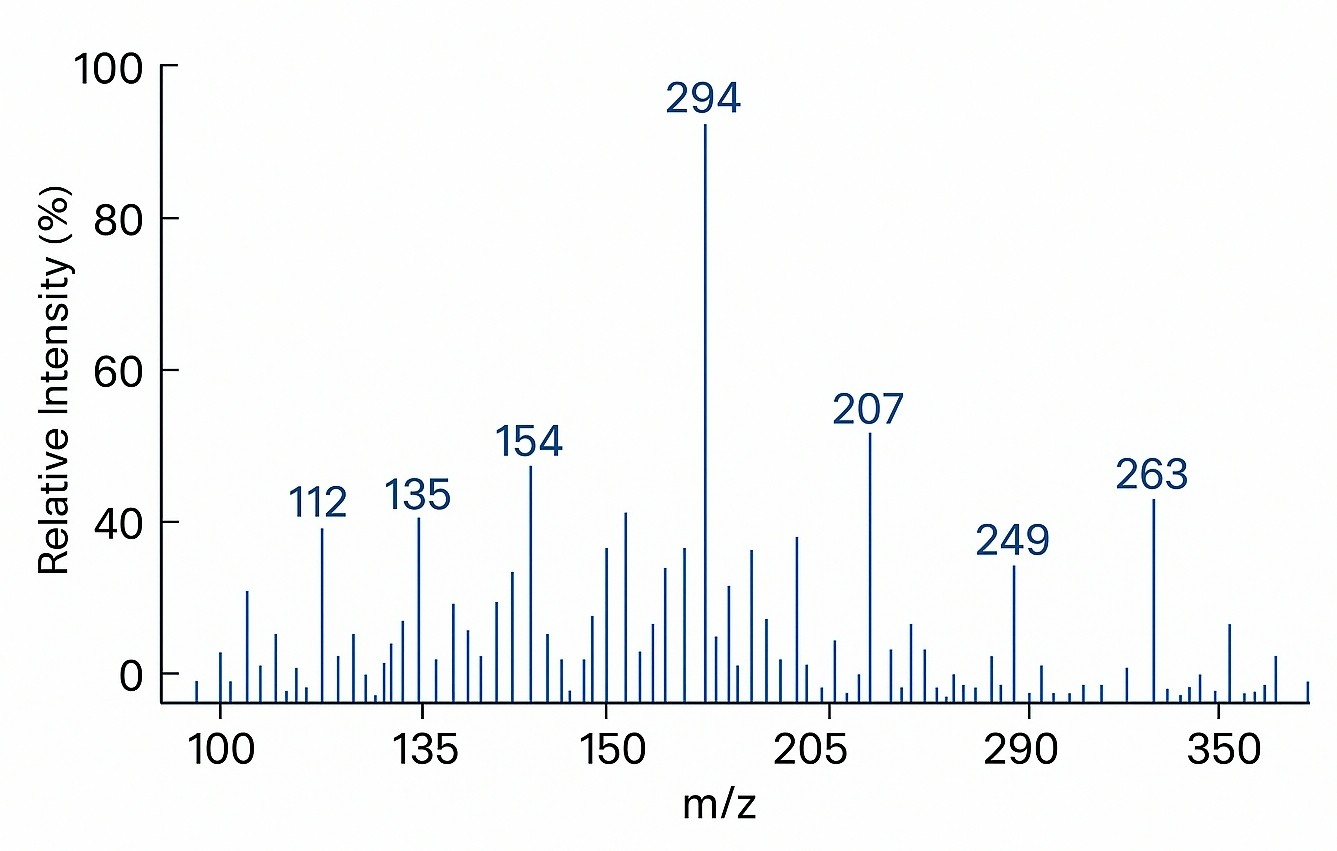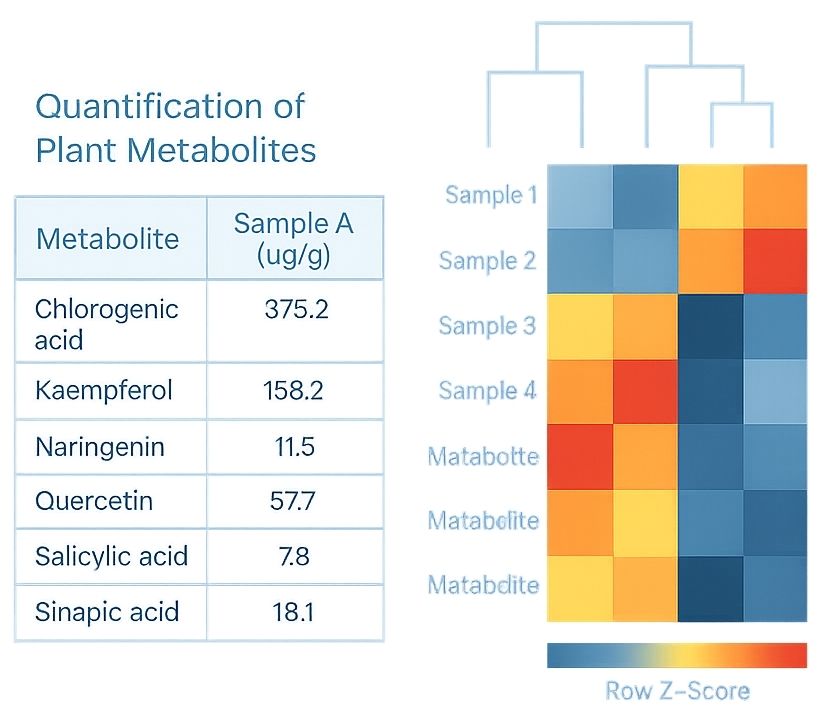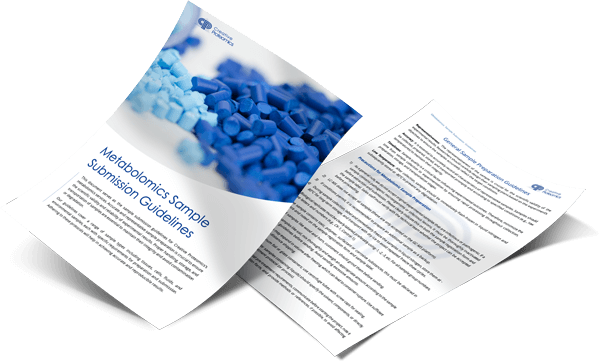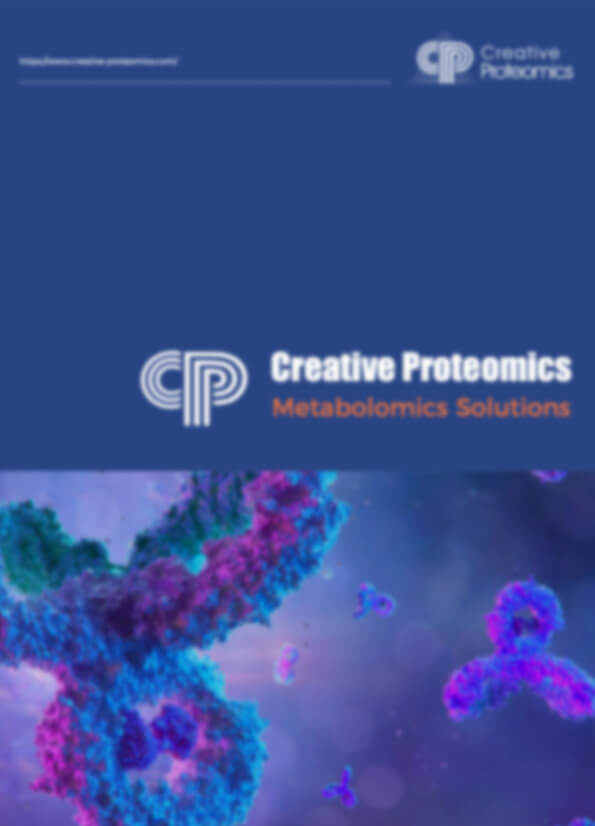Plant Targeted Metabolomics Service
Creative Proteomics empowers plant research and industry with high-sensitivity targeted metabolomics, revealing critical biomarkers, supporting breeding, and ensuring product quality. Turn complex data into actionable insights for confident decision-making.
- Ultra-sensitive detection to pg/mL levels for key metabolites
- Customizable panels for stress response, quality, and trait profiling
- Comprehensive data reports with biological interpretation
- Advanced instrumentation: LC-MS/MS, GC-MS/MS, UHPLC-QTOF-MS
Submit Your Request Now
×- What We Provide
- Technology Platform
- Sample Requirement
- Demo
- Case
- FAQ
What is Plant Targeted Metabolomics?
Plant targeted metabolomics is a precise analytical approach designed to quantify specific, predefined metabolites within plant samples. Unlike untargeted metabolomics, which surveys the entire metabolome without prior bias, targeted metabolomics focuses on known metabolites of interest, delivering robust quantitative data crucial for applications such as plant breeding, stress physiology, metabolic engineering, and quality control in agricultural products.
Targeted analysis allows researchers to:
- Monitor key biosynthetic pathways (e.g., flavonoids, alkaloids, phytohormones)
- Quantify stress biomarkers under biotic and abiotic stress
- Authenticate plant-derived materials
- Correlate metabolite levels with phenotypic traits for breeding programs
Through accurate measurement of defined metabolite panels, targeted metabolomics serves as an indispensable tool for driving discoveries in plant science and delivering actionable data for industrial applications.
Why Analyze Plant Targeted Metabolomics?

Quantitative Precision
Delivers absolute or relative quantification with picomolar to nanomolar sensitivity for precise comparisons across samples and conditions.
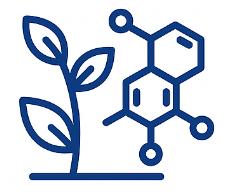
Biological Relevance
Targets key metabolites like phytohormones and defense compounds, directly linking data to plant physiology and traits.

Speed and Efficiency
Enables fast, high-throughput analysis of defined compounds, minimizing run time and data complexity.

Regulatory and Quality Compliance
Confirms metabolite identities and levels to meet regulatory standards in food, herbal, and plant-derived products.
Creative Proteomics's Plant Targeted Metabolomics Profiling Services
- Stress Response Profiling: Quantitative analysis of metabolites involved in abiotic (drought, salinity, heat) and biotic (pathogen, pest) stress adaptation.
- Metabolic Pathway Analysis: Targeted detection of intermediates and end-products across specific biosynthetic or catabolic pathways for pathway flux elucidation.
- Quality and Authenticity Testing: Customized panels to verify the biochemical fingerprint of plant-derived products, ensuring batch consistency and detecting adulteration.
- Trait-Linked Metabolite Profiling: Identification and quantification of metabolites correlated with agronomic traits such as yield, taste, nutritional value, or shelf life.
- Breeding Program Support: Targeted screening of candidate metabolites to accelerate selection in breeding pipelines.
- Post-Harvest Metabolism Studies: Measurement of compounds linked to storage stability, ripening, senescence, and post-harvest physiology.
- Bioactive Compound Quantification: Focused quantification of bioactive compounds relevant for nutraceutical, pharmaceutical, and functional food applications.
- Comparative Studies Across Varieties or Treatments: High-sensitivity targeted analyses to identify metabolic shifts between plant genotypes, growth conditions, or treatments.
List of Detected Plant Metabolites
| Metabolite Class | Representative Compounds |
|---|---|
| Phytohormones | Indole-3-acetic acid (IAA), Salicylic acid, Abscisic acid (ABA), Jasmonic acid, Methyl jasmonate, Gibberellic acids (GA1, GA3, GA4), Zeatin, Zeatin riboside, Kinetin, Brassinolide, Strigolactones, Ethylene precursors (ACC) |
| Flavonoids | Quercetin, Kaempferol, Rutin, Luteolin, Apigenin, Myricetin, Naringenin, Catechin, Epicatechin, Delphinidin, Cyanidin, Pelargonidin, Procyanidins, Isoflavones (Genistein, Daidzein) |
| Phenolic Acids & Derivatives | Chlorogenic acid, Caffeic acid, Ferulic acid, Sinapic acid, p-Coumaric acid, Gallic acid, Syringic acid, Vanillic acid, Protocatechuic acid, Hydroxybenzoic acid, Salicylic acid glucoside |
| Alkaloids | Nicotine, Strychnine, Caffeine, Theobromine, Berberine, Morphine, Colchicine, Vincristine, Solanine, Atropine, Scopolamine |
| Glucosinolates | Glucoraphanin, Sinigrin, Gluconasturtiin, Glucoiberin, Glucobrassicin, 4-Methoxyglucobrassicin, Neoglucobrassicin |
| Amino Acids | Glutamate, Glutamine, Aspartate, Asparagine, Alanine, Valine, Leucine, Isoleucine, Phenylalanine, Tyrosine, Lysine, Arginine, Proline, Histidine, Serine, Threonine, Methionine, Glycine |
| Organic Acids | Citric acid, Malic acid, Fumaric acid, Succinic acid, Oxalic acid, Shikimic acid, Pyruvic acid, Tartaric acid, Lactic acid, Acetic acid, Propionic acid, Benzoic acid |
| Sugars & Sugar Alcohols | Glucose, Fructose, Sucrose, Maltose, Raffinose, Stachyose, Trehalose, Mannose, Galactose, Xylose, Ribose, Sorbitol, Mannitol, Inositol |
| Terpenoids | Limonene, Farnesol, Geraniol, Nerol, Phytol, β-Carotene, Lycopene, α-Tocopherol, Squalene, Gibberellins, Abietic acid, Taxol, Artemisinin |
| Polyamines | Putrescine, Spermidine, Spermine, Cadaverine, Agmatine |
| Fatty Acids & Lipids | Linoleic acid, Linolenic acid, Palmitic acid, Oleic acid, Stearic acid, Myristic acid, Arachidonic acid, Phosphatidylcholine, Phosphatidylethanolamine, Digalactosyldiacylglycerol (DGDG), Monogalactosyldiacylglycerol (MGDG) |
| Vitamins & Cofactors | Vitamin C (Ascorbic acid), Vitamin E (Tocopherols), Riboflavin, Niacin, Pantothenic acid, Folic acid, Biotin, Thiamine, Pyridoxine |
| Carotenoids | β-Carotene, Lycopene, Zeaxanthin, Lutein, Violaxanthin, Neoxanthin |
| Coumarins | Umbelliferone, Scopoletin, Esculetin, Fraxetin, Psoralen |
| Lignans & Stilbenes | Pinoresinol, Secoisolariciresinol, Matairesinol, Resveratrol, Pterostilbene |
| Benzoxazinoids | DIMBOA, DIBOA (benzoxazinone derivatives, important in cereals) |
| Saponins | Soyasaponins, Ginsenosides, Aescin, Dioscin |
| Betalains | Betanin, Indicaxanthin, Vulgaxanthin |
| Tannins | Hydrolysable tannins, Condensed tannins (proanthocyanidins) |
| Osmolytes | Glycine betaine, Proline, Trehalose, Mannitol, Sorbitol |
Methods and Instrumentation for Plant Targeted Metabolomics Analysis
LC-MS/MS (Triple Quadrupole Systems)
- Instrument Models: SCIEX Triple Quad™ 6500+, Thermo TSQ Altis™
- Applications: Phytohormones, polyphenols, alkaloids, glucosinolates
- Key Parameters:
- MRM (Multiple Reaction Monitoring) for selectivity and sensitivity
- Sensitivity limits as low as 0.1 pg/mL for certain phytohormones
- Linear dynamic ranges exceeding 104 fold
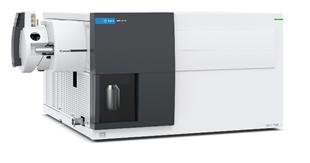 Agilent 6495C Triple quadrupole (Figure from Agilent)
Agilent 6495C Triple quadrupole (Figure from Agilent)
UHPLC-QTOF-MS
- Instrument Models: Agilent 6545 Q-TOF, Bruker Impact II
- Applications: High-resolution analysis of terpenoids, flavonoids, and unknown metabolites
- Key Parameters:
- Mass accuracy < 3 ppm
- Resolving power up to 40,000 FWHM
- MS/MS spectral acquisition for structural elucidation
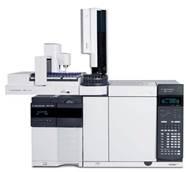 Agilent 7890B-5977A (Figure from Agilent)
Agilent 7890B-5977A (Figure from Agilent)
GC-MS/MS
- Instrument Models: Agilent 7890B/7000D Triple Quad
- Applications: Analysis of volatile metabolites, certain organic acids, sugars (after derivatization)
- Key Parameters:
- EI or CI ionization modes
- Detection limits in the low ng/mL range
HPLC with UV/FLD Detection
- Applications: Targeted analysis of compounds with strong UV absorbance or fluorescence (e.g., certain phenolics, alkaloids)
- Key Parameters:
- Rapid separation times
- Limits of detection typically in the sub-µM range
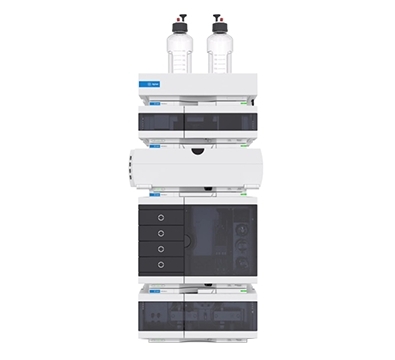 Agilent 1260 Infinity II HPLC (Figure from Agilent)
Agilent 1260 Infinity II HPLC (Figure from Agilent)
Analytical Workflow: Your Path to Reliable Plant Targeted Metabolomics Data
1. Project Consultation & Experimental Design
Define research goals and select relevant metabolite panels based on species and objectives. Discuss sample types, quantification methods, and reporting formats.
2. Sample Collection & Shipping
Collect plant materials, flash-freeze in liquid nitrogen, store at −80°C, and ship on dry ice as per guidelines.
3. Sample Preparation
- Homogenization under cold conditions to prevent degradation.
- Precise weighing and aliquoting.
- Metabolite extraction using solvent systems optimized for target classes (e.g., methanol/water, acidified solvents).
- Protein precipitation and removal of interfering matrix components.
- Concentration and reconstitution in analysis-specific solvents.
4. Internal Standard Spiking
Addition of isotope-labeled internal standards for quantitative accuracy. Calibration curve preparation with authentic standards for absolute quantification.
5. Instrumental Analysis
Use LC-MS/MS, GC-MS/MS, or HPLC-UV/FLD for targeted analysis depending on the metabolites, with optimized methods for each.
6. Data Processing & Quality Control
Quantify metabolites via calibration or peak ratios, perform quality control checks, and apply multivariate analyses if needed.
7. Data Reporting & Interpretation
Deliver a comprehensive report with quantified metabolites, statistical summaries, visualizations, and optional bioinformatics support.
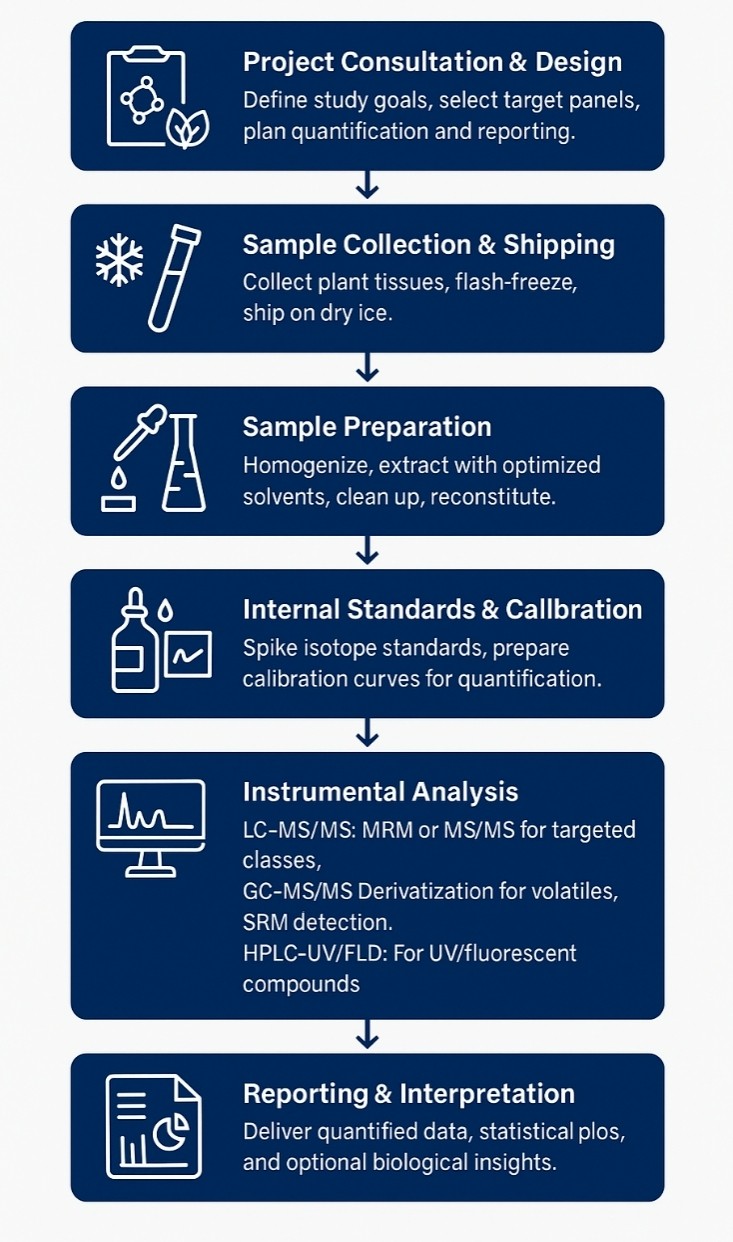
Sample Requirements for Plant Targeted Metabolomics Service
| Item | Details |
|---|---|
| Sample Types | Leaves, stems, roots, seeds, fruits, whole plants, extracts |
| Minimum Amount | Fresh tissue: ≥ 200 mg Dry tissue: ≥ 50 mg Liquid extract: ≥ 200 μL |
| Preferred Condition | Fresh or frozen; avoid wilting or drying before freezing |
| Storage Temperature | −80°C immediately after collection |
| Shipping Condition | Transport on dry ice; avoid thawing |
| Container | Sealed Eppendorf tubes, screw-cap vials, or cryovials |
| Additional Info | Provide sample list with IDs, tissue type, species, and treatments |
Demo Results
Plant Targeted Metabolomics Analysis Service Case Study
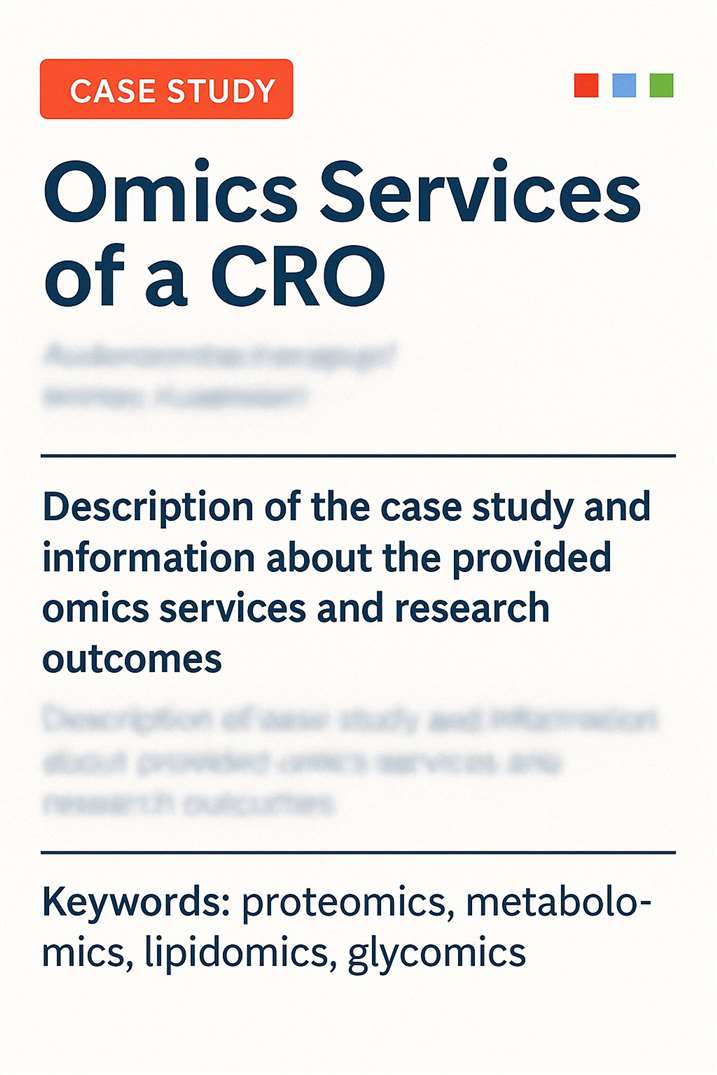
Title: Glucocorticoid-induced osteoporosis is prevented by dietary prune in female mice
Journal: Frontiers in Cell and Developmental Biology
Published: 2024
- Background
- Methods
- Results
- Conclusion
- Reference
Long-term glucocorticoid (GC) therapy is widely used for inflammatory diseases but leads to glucocorticoid-induced osteoporosis (GIO), a major cause of secondary osteoporosis. There is growing interest in natural interventions like dietary prune (DP), known for beneficial effects on bone and gut microbiota, but its impact on GIO was untested.
In this study, Creative Proteomics supported the comprehensive profiling of prune powder and experimental diets. Using advanced LC-MS/MS analysis, we quantified key polyphenols and flavonoids, establishing a chemical fingerprint crucial for interpreting biological effects. Female mice were fed diets containing 0%, 5%, 15%, or 25% prune powder while undergoing GC or placebo treatment for eight weeks. Bone health was assessed via micro-CT, and gut microbiota changes were analyzed through 16S rRNA sequencing and machine learning approaches to link microbial shifts with bone outcomes.
- Creative Proteomics' polyphenol data confirmed elevated compounds like chlorogenic acid and rutin in prune diets, known for bone-protective effects.
- Even low-dose DP (5%) fully prevented GC-induced loss of trabecular bone in the femur.
- Higher doses (25%) not only protected against GIO but increased trabecular bone volume up to threefold in healthy mice, a unique finding for gut-targeted dietary interventions.
- DP supplementation significantly shifted gut microbiota composition, notably increasing Bacteroides, positively correlated with bone volume, and decreasing potentially harmful taxa like Clostridium sensu stricto 1.
- The combined data suggest DP's benefits stem from its polyphenol content and prebiotic effects, modulating the gut-bone axis.
Creative Proteomics' analytical capabilities were pivotal in identifying prune's bioactive compounds and linking them to bone health outcomes. This study establishes DP as a promising natural strategy to prevent GIO and highlights the gut microbiota as a therapeutic target in bone health management.
Reference
- Chargo, Nicholas J., et al. "Glucocorticoid-induced osteoporosis is prevented by dietary prune in female mice." Frontiers in Cell and Developmental Biology 11 (2024): 1324649. https://doi.org/10.3389/fcell.2023.1324649
FAQ of Plant Targeted Metabolomics Analysis Service
Can I analyze rare or exotic plant species?
Yes. As long as sufficient sample quantity is provided and metabolites are chemically amenable to extraction and detection, we can customize targeted panels even for rare species.
Can I submit processed extracts instead of raw plant tissues?
Absolutely. We accept both raw tissues and prepared extracts. Please share details on the extraction solvent and concentration to ensure compatibility with our methods.
How many metabolites can you analyze in a single run?
Depending on the panel and instrument, we can quantify up to several hundred metabolites simultaneously without compromising data quality.
What sample replicates do you recommend?
Biological triplicates are typically advised for statistical reliability. Technical replicates may also be included to assess instrument precision.
Can I integrate your data with my transcriptomics or proteomics results?
Yes. We deliver data formats compatible with multi-omics integration and can discuss tailored bioinformatics support for cross-omics analyses.
What internal standards do you use for plant metabolites?
We employ isotope-labeled standards whenever available, especially for phytohormones and small polar compounds. For classes without commercial isotope standards, we use closely related analogs for semi-quantification.
How do you handle matrix effects in plant extracts?
Matrix effects are evaluated via post-extraction spiking experiments. Signal suppression or enhancement factors are calculated and applied as correction factors where necessary.
Are your calibration curves matrix-matched?
Yes, for critical metabolites, we prepare calibration curves in matrix-matched solutions to account for plant matrix complexity and improve quantification accuracy.
What limits of detection (LOD) can you achieve for plant metabolites?
LODs vary by compound class but can reach low picogram per milliliter (pg/mL) levels for phytohormones and low nanogram levels for most secondary metabolites.
Do you perform polarity switching in LC-MS/MS runs?
Yes, for panels containing both acidic and basic metabolites, we use polarity switching within a single run to maximize coverage without compromising data quality.
How do you validate metabolite identification?
Identification is confirmed by matching retention times and MS/MS fragmentation patterns to authentic standards. For unknowns, high-resolution mass spectra and fragmentation libraries are used.
Is isotope dilution used for all quantified metabolites?
Not always. Isotope dilution is applied where isotope-labeled standards exist. For metabolites without standards, external calibration curves and relative quantification are used.
Can you separate isomers in targeted assays?
Yes, we optimize chromatographic conditions (e.g., gradient, column chemistry, mobile phase pH) specifically to separate critical isomers like flavonoids or glucosinolates.
How do you control batch effects in large studies?
We insert pooled QC samples at regular intervals, normalize data against QC signals, and evaluate batch variation statistically before combining datasets.
Learn about other Q&A about proteomics technology.
Publications
Here are some of the metabolomics-related papers published by our clients:

- Methyl donor supplementation reduces phospho‐Tau, Fyn and demethylated protein phosphatase 2A levels and mitigates learning and motor deficits in a mouse model of tauopathy. 2023. https://doi.org/10.1111/nan.12931
- A human iPSC-derived hepatocyte screen identifies compounds that inhibit production of Apolipoprotein B. 2023. https://doi.org/10.1038/s42003-023-04739-9
- The activity of the aryl hydrocarbon receptor in T cells tunes the gut microenvironment to sustain autoimmunity and neuroinflammation. 2023. https://doi.org/10.1371/journal.pbio.3002000
- Lipid droplet-associated lncRNA LIPTER preserves cardiac lipid metabolism. 2023. https://doi.org/10.1038/s41556-023-01162-4
- Inflammation primes the kidney for recovery by activating AZIN1 A-to-I editing. 2023. https://doi.org/10.1101/2023.11.09.566426
- Anti-inflammatory activity of black soldier fly oil associated with modulation of TLR signaling: A metabolomic approach. 2023. https://doi.org/10.3390/ijms241310634
- Plant Growth Promotion, Phytohormone Production and Genomics of the Rhizosphere-Associated Microalga, Micractinium rhizosphaerae sp. 2023. https://doi.org/10.3390/plants12030651
